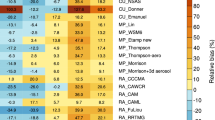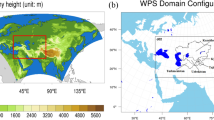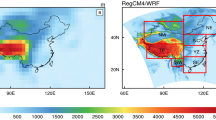Abstract
The non-hydrostatic Weather Research and Forecasting model (WRF) was nested into NCEP’s operational seasonal forecast model Climate Forecast System (CFS) to downscale seasonal prediction of winter precipitation over continental China. Using the same initial conditions, 16 ensemble downscaling forecasts configured with two alternative schemes of microphysics, cumulus, land surface and radiation in WRF were conducted at 30 km for 27-cold seasons (December–February) during 1982–2008. On average, WRF downscaling forecasts reduced wet bias of seasonal mean precipitation from CFS prediction by 25–71%, decreased errors by up to 33%, and increased equitable threat score by 0.1 for low threshold. With appropriate physical configurations, WRF could improve interannual variations over the region where CFS has correct anomaly signal. The spatial distribution of daily precipitation characteristics such as rainy frequency and extremes highlighted the sensitivity of downscaling forecasts to physical configurations, and the dominant uncertainties were introduced by land surface and radiation schemes. The differences in convective and resolved rainfall between alternative land surface and radiation schemes were consistent with differences of surface downwelling shortwave and longwave radiation through cloud-radiation feedback. Such feedback was strengthened in the land surface sensitivity experiments due to different parameterizations of surface albedo. As compared with CFS ensemble predictions with different initial conditions, the WRF ensemble downscaling forecasts with various physical schemes had larger spread, and some schemes could complement each other in different regions that provided a promising opportunity to enhance the prediction through optimization. The optimized WRF reduced error from the optimized CFS by 30% and increased pattern correlation by 0.12. Moreover, WRF physical configuration ensemble increased percentage of skillful probabilistic forecasts from CFS initial condition ensemble.












Similar content being viewed by others
References
Arakawa A (2004) The cumulus parameterization problem: past, present, and future. J Clim 17:2493–2525
Arribas A et al (2011) The GloSea4 ensemble prediction system for seasonal forecasting. Mon Weather Rev 139:1891–1910
Awan NK, Truhetz H, Gobiet A (2011) Parameterization-induced error characteristics of MM5 and WRF operated in climate mode over the Alpine region: an ensemble-based analysis. J Clim 24:3107–3123
Barnston AG, Mason SJ, Goddard L, DeWitt DG, Zebiak SE (2003) Multimodel ensembling in seasonal climate forecasting at IRI. Bull Am Meteorol Soc 84:1783–1796
Barnston AG, Li S, Mason SJ, DeWitt DG, Goddard L, Gong X (2010) Verification of the first 11 years of IRI’s seasonal climate forecasts. J Appl Meteor Climatol 49:493–520
Bukovsky MS, Karoly DJ (2009) Precipitation simulations using WRF as a nested regional climate model. J Appl Meteor Climatol 48:2152–2159
Chen F, Dudhia J (2001) Coupling an advanced land-surface/hydrology model with the Penn State/NCAR MM5 modeling system. Part I: model description and implementation. Mon Weather Rev 129:569–585
Chen M, Shi W, Xie P, Silva VBS, Kousky VE, Higgins RW, Janowiak JE (2008) Assessing objective techniques for gauge-based analyses of global daily precipitation. J Geophys Res 113:D04110. doi:10.1029/2007JD009132
Christensen JH, Christensen OB (2003) Climate modeling: severe summertime flooding in Europe. Nature 421:805–806
Clough SA, Shephard MW, Mlawer EJ, Delamere JS, Iacono MJ, Cady-Pereira K, Boukabara S, Brown PD (2005) Atmospheric radiative transfer modeling: a summary of the AER codes. J Quant Spectrosc Radiat Transf 91:233–244
Cocke S, LaRow TE (2000) Seasonal predictions using a regional spectral model embedded within a coupled ocean-atmosphere model. Mon Weather Rev 128:689–708
Cocke S, LaRow TE, Shin DW (2007) Seasonal rainfall predictions over the southeast United States using the Florida State University nested regional spectral model. J Geophys Res 112:D04106. doi:10.1029/2006JD007535
Collins WD et al (2004) Description of the NCAR community atmosphere model (CAM 3.0), NCAR Technical Note, NCAR/TN-464+STR, 226 pp
Crétat J, Pohl B, Richard Y, Drobinski P (2011) Uncertainties in simulating regional climate of Southern Africa: sensitivity to physical parameterizations using WRF. Clim Dyn. doi:10.1007/s00382-011-1055-8
Dai Y et al (2003) The common land model. Bull Am Meteor Soc 84:1013–1023
Daly C, Neilsen RP, Phillips DL (1994) A statistical-topographic model for mapping climatological precipitation over mountainous terrain. J Appl Meteor 33:140–158
DeWitt DG (2005) Retrospective forecasts of interannual sea surface temperature anomalies from 1982 to present using a directly coupled atmosphere-ocean general circulation model. Mon Weather Rev 133:2972–2995
Ding Y, Liu YM, Shi X, Li Q (2003) The experimental use of the regional climate model in the seasonal prediction in China National Climate Center. In: Proceedings of the 2nd workshop on regional climate model, Yokohama, Japan, 9–14
Ding Y, Shi X, Liu YM, Liu Y, Li Q, Qian Y, Miao M, Zhai G, Gao K (2006) Multi-year simulations and experimental seasonal predictions for rainy seasons in China by using a nested regional climate model (RegCM_NCC). Part I: sensitivity study. Adv Atmos Sci 23:323–341
Dudhia J, Hong SY, Lim KS (2008) A new method for representing mixed-phase particle fall speeds in bulk microphysics parameterizations. J Met Soc Japan 86:33–44
Ek MB, Mitchell KE, Lin Y, Rogers E, Grunmann P, Koren V, Gayno G, Tarpley JD (2003) Implementation of NOAH land surface model advances in the National Centers for Environmental Prediction operational mesoscale Eta model. J Geophys Res 108:8851. doi:10.1029/2002JD003296
Fennessy MJ, Shukla J (2000) Seasonal prediction over North America with a regional model nested in a global model. J Clim 13:2605–2627
Flaounas E, Bastin S, Janicot S (2011) Regional climate modeling of the 2006 West African monsoon sensitivity to convection and planetary boundary layer parameterization using WRF. Clim Dyn 36:1083–1105. doi:10.1007/s00382-010-0785-3
Gao XJ, Xu Y, Zhao ZC, Pal JS, Giorgi F (2006) On the role of resolution and topography in the simulation of East Asia precipitation. Theor Appl Climatol 86:173–185
Gao XJ, Zhang DF, Chen ZX, Pal JS, Giorgi F (2007) Land use effects on climate in China as simulated by a regional climate model. Sci China Ser D-Earth Sci 50:620–628
Gao XJ, Shi Y, Song R, Giorgi F, Wang Y, Zhang D (2008) Reduction of future monsoon precipitation over China: comparison between a high resolution RCM simulation and the driving GCM. Meteorol Atmos Phys 100:73–86
Giorgi F, Shields C (1999) Tests of precipitation parameterizations available in latest version of NCAR regional climate model (RegCM) over continental United States. J Geophys Res 104:6353–6375
Gochis D, Shuttleworth W, Yang Z (2002) Sensitivity of the modeled North American monsoon regional climate to convective parameterization. Mon Weather Rev 130:1282–1298
Grell GA (1993) Prognostic evaluation of assumptions used by cumulus parameterizations. Mon Weather Rev 121:764–787
Grell GA, Dévényi D (2002) A generalized approach to parameterizing convection combining ensemble and data assimilation techniques. Geophys Res Lett 29:1693
Hong SY, Lim JOJ (2006) The WRF Single-Moment 6-Class Microphysics Scheme (WSM6). J Korean Meteor Soc 42:129–151
Hong SY, Dudhia J, Chen SH (2004) A Revised Approach to Ice Microphysical Processes for the Bulk Parameterization of Clouds and Precipitation. Mon Weather Rev 132:103–120
Hong SY, Noh Y, Dudhia J (2006) A new vertical diffusion package with an explicit treatment of entrainment processes. Mon Weather Rev 134:2318–2341
Iacono MJ, Delamere JS, Mlawer EJ, Shephard MW, Clough SA, Collins WD (2008) Radiative forcing by long-lived greenhouse gases: calculations with the AER radiative transfer models. J Geophys Res 113:D13103. doi:10.1029/2008JD009944
Ji M, Kumar A, Leetmaa A (1994) A multiseason climate forecast system at the National Meteorological Center. Bull Am Meteorol Soc 75:569–577
Kain JS (2004) The Kain-Fritsch convective parameterization: an update. J Appl Meteor 43:170–181
Koster RD et al (2010) Contribution of land surface initialization to subseasonal forecast skill: first results from a multi-model experiment. Geophys Res Lett 37:L02402. doi:10.1029/2009GL041677
Koster RD et al (2011) The second phase of global land-atmosphere coupling experiments: soil moisture contributions to subseasonal forecast skill. J Hydrometeorol 12:805–822. doi:10.1175/2011JHM1365.1
Lavers D, Luo L, Wood EF (2009) A multiple model assessment of seasonal climate forecast skill for applications. Geophys Res Lett 36:L23711. doi:10.1029/2009GL041365
Liang XZ, Li L, Dai A, Kunkel KE (2004a) Regional climate model simulation of summer precipitation diurnal cycle over the United States. Geophys Res Lett 31:L24208. doi:10.1029/2004GL021054
Liang XZ, Li L, Kunkel KE, Ting M, Wang JXL (2004b) Regional climate model simulation of U.S. precipitation during 1982–2002. Part I: annual cycle. J Clim 17:3510–3528
Liang XZ, Xu M, Kunkel KE, Grell GA, Kain J (2007) Regional climate model simulation of U.S.-Mexico summer precipitation using the optimal ensemble of two cumulus parameterizations. J Clim 20:5201–5207. doi:10.1175/JCLI4306.1
Liang XZ, Xu M, Yuan X et al (2011) Regional climate-weather research and forecasting model (CWRF). Bull Am Meteorol Soc (submitted)
Liu JY, Liu ML, Zhuang DF, Zhang ZX, Deng XZ (2003) Study on the spatial pattern of land-use change in China during 1995–2000. Sci China Ser D-Earth Sci 46:373–384
Luo L, Wood EF (2008) Use of Bayesian merging techniques in a multimodel seasonal hydrologic ensemble prediction system for the eastern United States. J Hydrometeorol 9:866–884
Mesinger F, Black TL (1992) On the impact of forecast accuracy of the step-mountain (Eta) vs. sigma coordinate. Meteorol Atmos Phys 50:47–60. doi:10.1007/BF01025504
Mlawer EJ, Taubman SJ, Brown PD, Iacono MJ, Clough SA (1997) Radiative transfer for inhomogeneous atmosphere: RRTM, a validated correlated-k model for the longwave. J Geophys Res 102:16663–16682
Morcrette JJ, Barker HW, Cole JNS, Iacono MJ, Pincus R (2008) Impact of a new radiation package, McRad, in the ECMWF integrated forecasting system. Mon Weather Rev 136:4773–4798
Palmer TN et al (2004) Development of a European Multimodel Ensemble System for Seasonal-to-Interannual Prediction (DEMETER). Bull Am Meteorol Soc 85:853–872
Pohl B, Crétat J, Camberlin P (2011) Testing WRF capability in simulating the atmospheric water cycle over Equatorial East Africa. Clim Dyn 37:1357–1379. doi:10.1007/s00382-011-1024-2
Saha S et al (2006) The NCEP climate forecast system. J Clim 19:3483–3517
Saha S et al (2010) The NCEP climate forecast system reanalysis. Bull Am Meteorol Soc 91:1015–1057
Shukla J (1998) Predictability in the midst of chaos: a scientific basis for climate forecasting. Science 282:728–731
Skamarock WC, Klemp JB, Dudhia J, Gill D, Barker D, Duda M, Huang X, Wang W, Powers J (2008) A description of the advanced research WRF version 3. NCAR technical note, NCAR/TN-475+STR, 125 pp
Smirnova TG, Brown JM, Benjamin SG (1997) Performance of different soil model configurations in simulating ground surface temperature and surface fluxes. Mon Weather Rev 125:1870–1884
Smirnova TG, Brown JM, Benjamin SG, Kim D (2000) Parameterization of coldseason processes in the MAPS land-surface scheme. J Geophys Res 105:4077–4086
Stockdale TN, Anderson DLT, Alves JOS, Balmaseda MA (1998) Global seasonal rainfall forecasts using a coupled ocean-atmosphere model. Nature 392:370–373
Sun L, Moncunill DF, Li H, Moura AD, Filho FDADS, Zebiak SE (2006) An operational dynamical downscaling prediction system for Nordeste Brazil and the 2002–04 real-time forecast evaluation. J Clim 19:1990–2007
Thompson G, Rasmussen RM, Manning K (2004) Explicit forecasts of winter precipitation using an improved bulk microphysics scheme. Part I: description and sensitivity analysis. Mon Weather Rev 132:519–542
Thompson G, Field PR, Rasmussen RM, Hall WD (2008) Explicit forecasts of winter precipitation using an improved bulk microphysics scheme. Part II: implementation of a new snow parameterization. Mon Weather Rev 136:5095–5115
Wang B, Yang HW (2008) Hydrological issues in lateral boundary conditions for regional climate modeling: simulation of east Asian summer monsoon in 1998. Clim Dyn 31:477–490
Wang B et al (2009) Advance and prospectus of seasonal prediction: assessment of the APCC/CliPAS 14-model ensemble retrospective seasonal prediction (1980–2004). Clim Dyn 33:93–117
Weisheimer A et al (2009) ENSEMBLES: a new multi-model ensemble for seasonal-to-annual predictions-Skill and progress beyond DEMETER in forecasting tropical Pacific SSTs. Geophys Res Lett 36:L21711. doi:10.1029/2009GL040896
Wilks DS (2006) Statistical methods in the atmospheric sciences, 2nd edn. Academic Press, Burlington
Xie P, Yatagai A, Chen M, Hayasaka T, Fukushima Y, Liu C, Yang S (2007) A gauge-based analysis of daily precipitation over east Asia. J Hydrometeorol 8:607–626
Xu Y, Gao XJ, Shen Y, Xu CH, Shi Y, Giorgi F (2009) A daily temperature dataset over China and its application in validating a RCM simulation. Adv Atmos Sci 26:763–772
Xue Y, Zeng FJ, Mitchell KE, Janjic Z, Rogers E (2001) The impact of land surface processes on simulations of the U.S. Hydrological cycle: a case study of the 1993 flood using the SSiB land surface model in the NCEP eta regional model. Mon Weather Rev 129:2833–2860
Yuan X, Liang XZ (2011) Improving cold season precipitation prediction by the nested CWRF-CFS system. Geophys Res Lett 38:L02706. doi:10.1029/2010GL046104
Yuan X, Xie Z, Zheng J, Tian X, Yang Z (2008) Effects of water table dynamics on regional climate: a case study over east Asian monsoon area. J Geophys Res 113:D21112. doi:10.1029/2008JD010180
Yuan X, Wood EF, Luo LF, Pan M (2011) A first look at Climate Forecast System version 2 (CFSv2) for hydrological seasonal prediction. Geophys Res Lett 38:L13402. doi:10.1029/2011GL047792
Zhou JL, Tits AL, Lawrence CT (1997) User’s guide for FFSQP version 3.7: A FORTRAN code for solving constrained nonlinear (minimax) optimization problems, generating iterates satisfying all inequality and linear constraint. Institute for Systems Research, University of Maryland Tech Rep SRC-TR-92-107r5, 44 pp
Zhu J, Liang XZ (2007) Regional climate model simulations of U.S. precipitation and surface air temperature during 1982–2002: interannual variation. J Clim 20:218–232
Acknowledgments
The CFS reforecast data was provided by the Environmental Modeling Center (EMC) at NCEP. We acknowledge NOAA/ESRL for the supercomputing support. We are grateful to two anonymous reviewers for their comments. The research was partially supported by the NOAA Climate Prediction Office through Grants NA17RJ2612 and NA10OAR4310246. The second author acknowledges the NOAA Climate Prediction Program for the Americas Grants NA08OAR4310575 and NA08OAR4310875.
Author information
Authors and Affiliations
Corresponding author
Rights and permissions
About this article
Cite this article
Yuan, X., Liang, XZ. & Wood, E.F. WRF ensemble downscaling seasonal forecasts of China winter precipitation during 1982–2008. Clim Dyn 39, 2041–2058 (2012). https://doi.org/10.1007/s00382-011-1241-8
Received:
Accepted:
Published:
Issue Date:
DOI: https://doi.org/10.1007/s00382-011-1241-8




